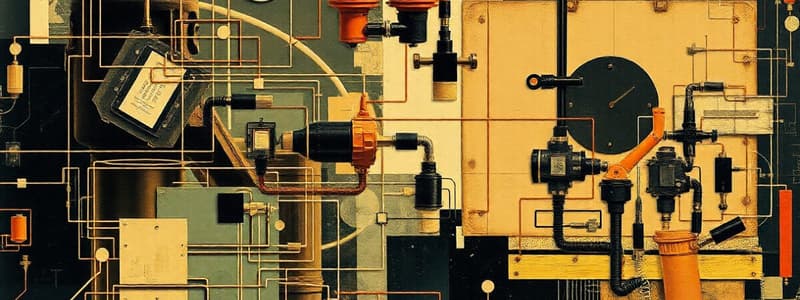Podcast
Questions and Answers
What is the primary function of sensing elements in an industrial sensor system?
What is the primary function of sensing elements in an industrial sensor system?
- To convert electrical power into motion
- To translate physical signals into electrical or pneumatic forms (correct)
- To amplify energy levels for actuator systems
- To compute control inputs for physical processes
How do actuation systems apply their computed control inputs to the physical process?
How do actuation systems apply their computed control inputs to the physical process?
- By converting signals into the appropriate physical variables like torque or flow (correct)
- By directly generating the control inputs without conversion
- By converting input signals into electric energy levels
- By translating physical variables into data form
What distinguishes actuators from sensors in an industrial system?
What distinguishes actuators from sensors in an industrial system?
- Actuators convert physical inputs into electrical signals
- Actuators are high power devices while sensors are not (correct)
- Actuators are usually battery-operated devices
- Actuators measure signals from the physical process
What does the process of amplification in actuators achieve?
What does the process of amplification in actuators achieve?
In the context of automation systems, what is the role of the control inputs produced by sensors?
In the context of automation systems, what is the role of the control inputs produced by sensors?
Which technology is NOT involved in the operation of an ATM?
Which technology is NOT involved in the operation of an ATM?
What is one of the primary purposes of automation in industrial settings?
What is one of the primary purposes of automation in industrial settings?
Which of the following is an example of automation in day-to-day life?
Which of the following is an example of automation in day-to-day life?
What advantage does automation provide by performing monotonous tasks?
What advantage does automation provide by performing monotonous tasks?
Which of the following components is part of the Automation Pyramid?
Which of the following components is part of the Automation Pyramid?
Flashcards are hidden until you start studying
Study Notes
Sensing and Actuation
- Sensing elements translate physical signals like temperature, pressure, or displacement into electrical or pneumatic information for analysis, decision-making, and control input calculation.
- Actuation elements convert computed control inputs (electrical or pneumatic information) into physical process inputs like heat, force, or flow rate to effect desired changes in process outputs.
Industrial Sensors and Instrument Systems
- Modern industrial systems use diverse sensors of different sizes, weights, costs, complexities, and technologies.
- All sensors consist of functional elements connected in a specified way to provide signals in a specific form for various automation tasks.
Industrial Actuator Systems
- Actuators convert control system output signals into forms applicable to the actual process, producing desired variations in physical variables.
- They convert controller output (information without power, in the form of electrical voltages or pneumatic pressure) into appropriate physical variables (like torque, heat, or flow).
- Actuators amplify the energy level of the signal to cause changes in process variables.
- Actuators are high-powered devices, unlike sensors.
- Actuators often produce motion from electrical signals, which is then converted to other forms.
Examples of Automation
- Day-to-day life: ATMs, vehicle starting, automatic washing machines, electrically driven pumps, UPS systems.
- Industry: Painting robots in the automobile industry, soldering machines, DCS (Distributed Control Systems), SCADA (Supervisory Control and Data Acquisition).
Technologies in ATM Working
- Computer and electronics (HMI)
- Communication using TCP/IP (Transmission Control Protocol/Internet Protocol) for server communication.
- Sensors: Magnetic sensors to read card data, cameras, timers.
- Electromechanical solenoids and actuators for accurate currency counting and dispensing.
- Printers for printing transactions.
Reasons for Automation
- Increased comfort.
- Improved safety.
- Enhanced quality and precision.
- Performing tasks beyond human capabilities.
- Avoiding monotonous work.
The Automation Pyramid
- Industrial automation systems are complex, involving numerous devices and technologies working synchronously.
- Understanding the different parts of the system is essential for evaluating its performance.
Optical Proximity Sensors
- These sensors use a light source (LED) and a light detector (phototransistor).
- Signal modulation minimizes ambient light conditions.
- Available in models with different power sources (12-30V DC, 24-240V AC).
- Outputs include TTL 5V, solid-state relays.
Optical Proximity Sensors: Operational Modes
- Through Beam: Long range (up to 20m), requiring precise alignment.
- Retro-reflective: Range of 1-3m, popular and cost-effective.
- Diffuse-reflective: Range of 12-300mm, inexpensive and easy to use.
When to Use Optical Proximity Sensors
- Pros: Non-contact, no moving parts, small size, fast switching, no switch bounce, insensitive to vibration and shock, and various configurations available.
- Cons: Requires alignment, susceptible to ambient light conditions (like welding), needs a clean, dust and water-free environment.
Applications of Optical Proximity Sensors
- Stack height control/box counting.
- Fluid level control (filling and clarity).
- Breakage and jam detection.
Ultrasonic Proximity Sensors
- These sensors emit ultrasonic sound waves and measure the time it takes for the waves to return, indicating the distance to an object.
When to Use Ultrasonic Sensors
- Provide range data directly.
- Level monitoring of solids and liquids.
- Approach warning (for collision avoidance).
- Can operate in heavy dust and water.
- Ambient noise can potentially affect performance.
Force and Pressure Sensors
- They measure force or pressure applied to the sensor.
- Common mechanisms include:
- Physical motion and measurement using LVDTs (Linear Variable Differential Transformers).
- Strain gauges (metal that changes resistance under stress).
- Piezoelectric materials that generate current when deformed.
Temperature Sensor Types
- Expansion thermometers (Mercury or Alcohol-based).
- Thermocouples.
- RTDs (Resistive Temperature Devices).
- Thermistors.
- Integrated Circuits.
- Infrared thermometers.
- Bimetals.
Thermocouples
- Based on the thermoelectric effect discovered by Thomas Johann Seebeck in 1821.
- A voltage is generated in a conductor when subjected to a temperature gradient.
- A thermocouple is formed when two dissimilar metals are in contact at one end, and voltage is measured between the other ends.
### Sensor Characteristic Curves
- Different sensor types have different relationships between the measured variable and the output signal.
- Graphs illustrate these relationships and are used for calibration and analysis.
### Example Sensor Characteristic Curves
- Shown are the curves for a thermocouple, an RTD (Resistance Temperature Detector), and a thermistor.
- Each curve shows the output signal (voltage or resistance) plotted against temperature.
- The curves demonstrate that different sensors have different sensitivities and ranges.
Studying That Suits You
Use AI to generate personalized quizzes and flashcards to suit your learning preferences.




